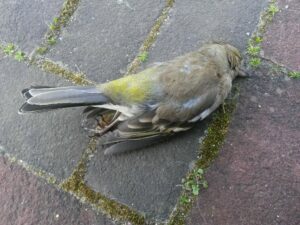Interim report: Greenfinch, DWHC focus species, 2016
The greenfinch and other species of finch were the focus species of the Dutch Wildlife Health Centre DWHC in 2016. These species were chosen in order to shed light on the presence of trichomonas infection in greenfinches and other finch sorts in the Netherlands.
Why trichomoniasis?
Trichomoniasis has long been recognised as a cause of death amongst doves, pigeons and birds of prey that have eaten them. In the last few years the disease has also been found in greenfinches and other species of finch. In the Netherlands the first case in a greenfinch was reported in 2009. In certain countries such as the UK, a decline in greenfinch numbers has been linked to trichomonas. In the Netherlands, a negative impact of trichomonas on the breeding population had not been noticed by 2015 (see population graphs on the Sovon website (see ‘aantalsontwikkeling’).
The disease is caused by infection with the parasite Trichomonas gallinae; there are several different strains which show varying pathogenicity.
In collaboration with Sovon, the Dutch Center for Field Ornithology, and the University of Utrecht, the DWHC are investigating the incidence and distribution of the different strains of Trichomonas gallinae that are found in the Netherlands as well as monitoring the greenfinch population.
Study results
A total of 91 finches from across the Netherlands were submitted to the DWHC for post-mortem exam in 2016. Of these, the majority (78) were greenfinches; there were also four hawfinches, one goldfinch, two siskins and five other finches. Two-thirds of these birds (mostly greenfinches) were infected with Trichomonas and the majority of infections were seen in the crop. This makes it difficult for the birds to eat and they can die from resultant intestinal hemorrhage if they go for 24-48 hours without food. At the end of 2016 researchers investigated the different strains of this parasite that were found in these birds.
The most important conclusion of this work to-date is the finding that Trichomonas was the main cause of death in greenfinches submitted to the DWHC from across the country.
Hygiene measures for garden bird-feeding
The disease can spread between birds via direct contact, particularly where they congregate at bird-feeders and drinkers. It is therefore important to clean these areas on a daily basis and to move feeders / drinkers regularly. Bird baths should be emptied, cleaned, allowed to air-dry and re-filled with clean water every day. Find out more about hygiene measures in our FAQ and about greenfinches on our species pages.
Photo Banner greenfinch: Dick Pasman




